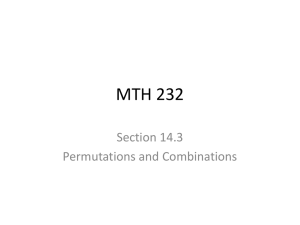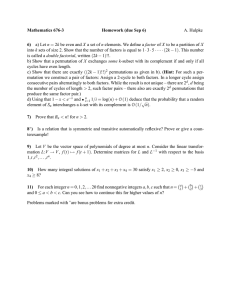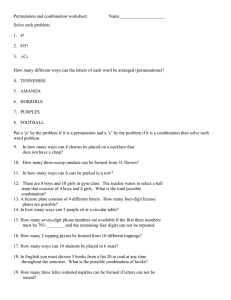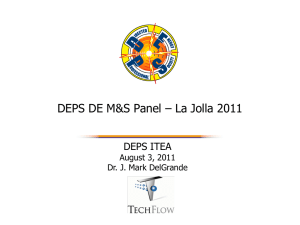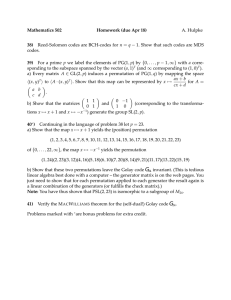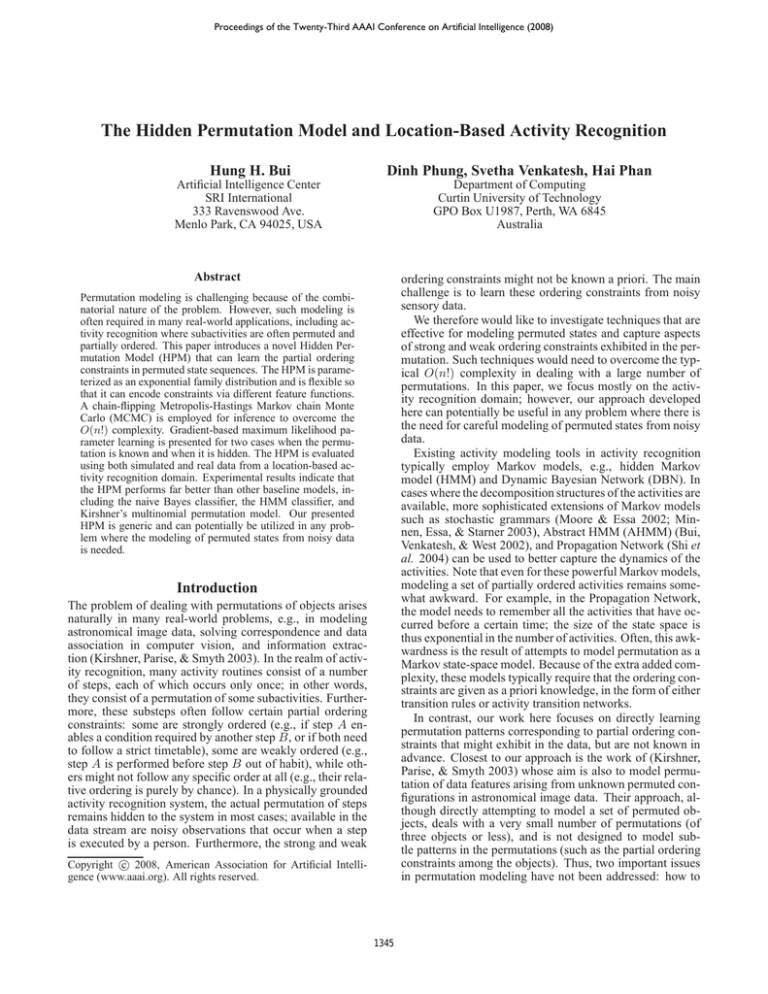
Proceedings of the Twenty-Third AAAI Conference on Artificial Intelligence (2008)
The Hidden Permutation Model and Location-Based Activity Recognition
Hung H. Bui
Dinh Phung, Svetha Venkatesh, Hai Phan
Artificial Intelligence Center
SRI International
333 Ravenswood Ave.
Menlo Park, CA 94025, USA
Department of Computing
Curtin University of Technology
GPO Box U1987, Perth, WA 6845
Australia
Abstract
ordering constraints might not be known a priori. The main
challenge is to learn these ordering constraints from noisy
sensory data.
We therefore would like to investigate techniques that are
effective for modeling permuted states and capture aspects
of strong and weak ordering constraints exhibited in the permutation. Such techniques would need to overcome the typical O(n!) complexity in dealing with a large number of
permutations. In this paper, we focus mostly on the activity recognition domain; however, our approach developed
here can potentially be useful in any problem where there is
the need for careful modeling of permuted states from noisy
data.
Existing activity modeling tools in activity recognition
typically employ Markov models, e.g., hidden Markov
model (HMM) and Dynamic Bayesian Network (DBN). In
cases where the decomposition structures of the activities are
available, more sophisticated extensions of Markov models
such as stochastic grammars (Moore & Essa 2002; Minnen, Essa, & Starner 2003), Abstract HMM (AHMM) (Bui,
Venkatesh, & West 2002), and Propagation Network (Shi et
al. 2004) can be used to better capture the dynamics of the
activities. Note that even for these powerful Markov models,
modeling a set of partially ordered activities remains somewhat awkward. For example, in the Propagation Network,
the model needs to remember all the activities that have occurred before a certain time; the size of the state space is
thus exponential in the number of activities. Often, this awkwardness is the result of attempts to model permutation as a
Markov state-space model. Because of the extra added complexity, these models typically require that the ordering constraints are given as a priori knowledge, in the form of either
transition rules or activity transition networks.
In contrast, our work here focuses on directly learning
permutation patterns corresponding to partial ordering constraints that might exhibit in the data, but are not known in
advance. Closest to our approach is the work of (Kirshner,
Parise, & Smyth 2003) whose aim is also to model permutation of data features arising from unknown permuted configurations in astronomical image data. Their approach, although directly attempting to model a set of permuted objects, deals with a very small number of permutations (of
three objects or less), and is not designed to model subtle patterns in the permutations (such as the partial ordering
constraints among the objects). Thus, two important issues
in permutation modeling have not been addressed: how to
Permutation modeling is challenging because of the combinatorial nature of the problem. However, such modeling is
often required in many real-world applications, including activity recognition where subactivities are often permuted and
partially ordered. This paper introduces a novel Hidden Permutation Model (HPM) that can learn the partial ordering
constraints in permuted state sequences. The HPM is parameterized as an exponential family distribution and is flexible so
that it can encode constraints via different feature functions.
A chain-flipping Metropolis-Hastings Markov chain Monte
Carlo (MCMC) is employed for inference to overcome the
O(n!) complexity. Gradient-based maximum likelihood parameter learning is presented for two cases when the permutation is known and when it is hidden. The HPM is evaluated
using both simulated and real data from a location-based activity recognition domain. Experimental results indicate that
the HPM performs far better than other baseline models, including the naive Bayes classifier, the HMM classifier, and
Kirshner’s multinomial permutation model. Our presented
HPM is generic and can potentially be utilized in any problem where the modeling of permuted states from noisy data
is needed.
Introduction
The problem of dealing with permutations of objects arises
naturally in many real-world problems, e.g., in modeling
astronomical image data, solving correspondence and data
association in computer vision, and information extraction (Kirshner, Parise, & Smyth 2003). In the realm of activity recognition, many activity routines consist of a number
of steps, each of which occurs only once; in other words,
they consist of a permutation of some subactivities. Furthermore, these substeps often follow certain partial ordering
constraints: some are strongly ordered (e.g., if step A enables a condition required by another step B, or if both need
to follow a strict timetable), some are weakly ordered (e.g.,
step A is performed before step B out of habit), while others might not follow any specific order at all (e.g., their relative ordering is purely by chance). In a physically grounded
activity recognition system, the actual permutation of steps
remains hidden to the system in most cases; available in the
data stream are noisy observations that occur when a step
is executed by a person. Furthermore, the strong and weak
c 2008, American Association for Artificial IntelliCopyright gence (www.aaai.org). All rights reserved.
1345
capture the partial ordering constraints, and how to scale up
to larger permutation sets.
To tackle these issues, we propose a novel model for permutation modeling called the Hidden Permutation Model
(HPM). The HPM consists of a distribution of permutations expressed as an exponential family with suitably designed features. Random permutation is drawn from the distribution and then serves as ordering indices to generate the
observations. Our work can be viewed as a generalization
of (Kirshner, Parise, & Smyth 2003) in which we replace
their naive multinomial permutation distribution with a more
suitable set of features and parametric form. To overcome
the O(n!) complexity, we employ the Metropolis-Hastings
Markov chain Monte Carlo (MCMC) with the chain-flipping
proposal scheme detailed in (Dellaert et al. 2003) for inference. We then provide algorithms for maximum-likelihood
parameter estimation for the HPM, both when the permutation is observed (supervised) and when the permutation
remains hidden (unsupervised).
We evaluate the model using both simulated data and real
data from a location-based activity recognition application
domain. In the latter, we use the HPM in combination with
density-based clustering (Ester et al. 1996) to detect the occurrences of high-level activity routines in a long sequence
of GPS signals. We show that the proposed HPM model outperforms other baseline models, including the naive Bayes
classifier, HMM classifier, and Kirshner’s multinomial permutation model.
The rest of the paper is organized as follows. We discuss
the related work next, followed by a detailed description of
the HPM and its learning algorithms. We then present the
setting of location-based activity recognition and the experimental results in evaluating the HPM for this domain. Finally, we conclude and present our future directions.
al. 2004), the high-level activity is modeled as a probabilistic network of atomic activities in which nodes represent
atomic activities and links represent partial ordering constraints among them. Joint conditional probability distributions are used to enforce the temporal and logical constraints
among parent nodes and their children. High-level activity
recognition is performed by belief propagation on the probabilistic network. However, in order to use this approach,
the structure of the high-level activity (ordering constraints)
needs to be known a priori. In our proposed HPM, these
constraints are modeled and learned directly via the feature
functions specified in the exponential family parameterization.
In DBN-based approaches, e.g., (Bui, Venkatesh, & West
2002; Yin, Chai, & Yang 2004; Wilson & Atkeson 2005),
high-level activity is often constructed hierarchically on top
of the atomic activities layer. These activities are usually treated as hidden variables, and standard inference and
learning techniques in DBN can be applied to learn and recognize activities. However, because of the strict first-order
assumption, it is hard for DBN-based approaches to capture long-range ordering and permutation constraints among
the atomic activities. The DBN-based approach has been
applied to location-based activity recognition where highlevel activities are inferred from low-level location information (Liao, Fox, & Kautz 2004). In this paper, we focus
however on activities that form out of a permuted sequence
of subactivities and on the problem of learning the ordering
constraints among them.
The HPM is based on a general exponential family formulation; thus, it is related to the conditional random fields
and relational Markov networks (Liao, Fox, & Kautz 2005).
However, the support of the HPM permutation distribution,
by definition, is restricted to the set of permutations. In addition, the features used in the HPM are designed to capture
partial-ordering relations. Furthermore, the HPM is a generative model which can be trained in an unsupervised way.
Related Work
Recognizing high-order activities is the central theme in
activity recognition research. Numerous approaches have
been proposed in literature, but to our best knowledge,
none has addressed the problem of learning partial ordering constraints from permuted activity sequences. Related
background is vast and we do not attempt to cover it all
here. Rather we focus on what is more closely related to
the work in this paper. Briefly, these approaches include
stochastic grammars (Moore & Essa 2002; Minnen, Essa,
& Starner 2003), probabilistic propagation networks (Shi et
al. 2004), DBN-based approaches (e.g., (Bui, Venkatesh,
& West 2002; Yin, Chai, & Yang 2004; Wilson & Atkeson 2005)), conditional random fields and relational Markov
networks (Liao, Fox, & Kautz 2005) and the naive Bayes
classifier (Tapia, Intille, & Larson 2004).
In stochastic grammar-based approaches (Moore & Essa
2002; Minnen, Essa, & Starner 2003), a high-level activity
is assumed to be generated from a set of atomic activities
via a grammar defined by a set of production rules. These
rules are often predefined manually, and the atomic activities
are observed during training and testing. High-level activity
recognition is performed by parsing a sequence of atomic
activities using parsing techniques in NLP with the predefined grammar.
In the probabilistic propagation network approach (Shi et
The Hidden Permutation Model
Let {a1 , . . . , an } be the set of n objects (e.g., subactivities in our case), each ai can generate an observation
w with the emission probability P (w | ai ) where w =
1, . . . , m. Let P er(n) be the set of all possible permutations over {1, 2, . . . , n}. We define the generative process of an n-order HPM as follows. First a permutation
X = {x1 , . . . , xn } ∈ P er(n) is generated according to a
distribution P (X). Then each xt is used as an index to generate the observation ot = w from the emission probability
P (w | axt ). For our convenience, we will use the notation
x−1
j to denote the position i such that xi = j.
x1
x2
xn−1
xn
o1
o2
on−1
on
Figure 1: Graphical model for HPM
Figure 1 illustrates the HPM as a graphical model. Note
that the structure of the model is somewhat similar to an
1346
HMM, except that the hidden state sequence is now a random permutation, and thus Markov properties do not hold;
in fact, {xi } form a fully connected Bayesian network.
However, at the observation layer, each observation ot depends only on xt . With a slight abuse of notation we write
P (ot | xt ) to mean P (ot | axt ). The joint distribution of all
variables in the model is given as
However,
mean-parameterization requires two constraints:
Pm
η
= 1, ∀i and 0 ≤ ηiv ≤ 1. These constraints make
iv
v=1
maximum likelihood estimation a constrained optimization
problem, which is inconvenient to solve. We therefore prefer to work with a minimal canonical parameterization as
follows
(m−1
)
X
P (w | ai , ηi ) = exp
ηiv I{v = w} − B(ηi )
(2)
P (X, O | θ) = P (X | λ)P (O | X, η)
n
Y
= P (X | λ)
P (ot | xt , η)
v=1
Pm−1
where B(ηi ) = ln(1+ v=1 eηiv ) is the log-partition function. With canonical parameterization, there are no constraints on the parameter ηiv .
In summary, the HPM is parameterized by θ = (λ, η)
where λ = {λij ∈ R, 1 ≤ i 6= j ≤ n} are canonical
parameters for P (X | λ), and η = {ηiv ∈ R, 1 ≤ i ≤
n, 1 ≤ v ≤ m − 1} are multinomial canonical parameters
for the observation model.
t=1
Here θ = {λ, η} is the parameter of the model: λ parameterizes the permutation probability P (X | λ) and η parameterizes the observation model P (O | X, η).
There are n! elements in P er(n), so it would take n! parameters if P (X) is modeled as a multinomial as in (Kirshner, Parise, & Smyth 2003). This approach is clearly not
scalable in terms of computational complexity and, more important, sample complexity.
The key idea of our contribution is a general parameterization of the permutation distribution based on the exponential family. Let f : P er(n) → Rd be a d-dimension feature
function, and λ ∈ Rd be the parameter in our model. We
consider an exponential family of the form
MCMC for Approximate Inference
Given a sequence of observations O = {o1 , . . . , on }, the
inference task is to compute the conditional probability
Q
P (X | λ) ni=1 P (oi |axi , η)
Qn
P (X | O, θ) = P
X∈P er(n) P (X | λ)
i=1 P (oi | axi , η)
P (X | λ) = exp {hf (X), λi − A(λ)}
where
P h·, ·i denotes the inner product, and A(λ) =
ln X∈P er(n) exp{hf (X), λi} is the log normalizer (a.k.a.
log-partition function).
The different choice of feature functions gives us great
flexibility in modeling the characteristics that we care about
in the permutation. One way to capture the long-range ordering constraints1 among subactivities is to define the features as f (X) = {fij (X), 1 ≤ i, j ≤ n} where fij (X) =
I{x−1
< x−1
i
j }, e.g., 1 if i appears before j in the permutation X and 0 otherwise. The inner-product hf (X), λi becomes
X
X
X
λij I{x−1
< x−1
λxl xk I{l < k} =
λxl xk
i
j } =
i,j
1≤l<k≤n
l,k
We thus arrive at the following model:
X
P (X | λ) = exp
λxl xk − A(λ)
(1)
1≤l<k≤n
In contrast to the multinomial model, this model has only
n(n − 1) parameters.
To complete the model, we employ multinomial distribution for the emission probability P (O | X, η). The straightforward choice is to define P (ot = w | ai ) = ηiw . This
is known as the mean-parameterization for the multinomial.
We are also interested in calculating the likelihood of the
model θ with respect to the observation sequence O , i.e.,
the probability
X
Y
P (O| θ) =
P (X | λ)
P (oi | xi , η)
X∈P er(n)
i
Note that this is also the denominator that appears in the
expression for P (X | O, θ).
The inference problem requires summation over all possible permutations in P er(n), which takes n! operations and
is clearly not scalable. In this paper, we propose to use a
Metropolis-Hastings MCMC approximation
PR Q at this step:
X
Y
r
r=1
j P (oj |axj , η)
P (X | λ)
P (oi |axi , η) ≈
R
i
X
where X r ∼ P (X|λ) and R is the number of samples. To
simulate from P (X|λ) via MCMC, we use the flipping proposal distribution in (Dellaert et al. 2003). From a current permutation X, we generate the next permutation X ′ by
swapping two random positions in X. This proposal distribution
and thus the acceptance ratio
n is symmetric,
o becomes
P
P (X ′ |λ)
min P (X|λ) = exp{ l<k (λx′l x′k − λxl xk )}, 1 .
Parameter Estimation
We present maximum likelihood (ML) parameter estimation
for the model, first in the case where all variables {X, O} are
observed and then for the case where X is hidden.
Supervised learning with observed permutation Given
the fully labeled
dataset D consisting
of K i.i.d. training
sequences X k , Ok , k = 1, . . . , K , ML estimation is the
solution
1
Another useful set of features can be constructed to focus on
neighboring positions: fij (X) = 1 if i appears immediately before
j in the permutation and 0 otherwise. Yet another useful set of
features can focus on value at a given position: fi,l (X) = 1 if i
appears at position l and 0 otherwise. In this paper, we use only
features that lead to the form in Eq. (1).
θML = argmax P (D | θ) = argmax L(D; θ)
θ
1347
θ
Activity Recognition on Campus
where L(D; θ) = ln P (D | θ) is the complete loglikelihood:
A student’s activities on campus are rarely random. Some
are spontaneous and are not bound to any strict schedule
such as having coffee with friends, reading in the library,
going banking, and so on. But often they are driven by a
timetable such as when to take a class, where to meet for
assigments, when to attend a seminar, and so on. Daily routines of a student can thus be viewed as a sequence of partially ordered ‘atomic’ activities.
We are interested in identifying and extracting such typical routine segments from location information contained in
long daily GPS traces. The problem is non-trivial since several atomic activities might take place in the same known location. Furthermore, because of the proximity between campus buildings, locations of interest might not be detected or
distinguishable from one another via GPS signals alone. We
use a two-stage approach to this problem. In the first stage,
raw GPS signals are clustered to find locations of significance where activities might take place. In the second stage,
sequences of raw GPS signals are converted to sequences of
cluster labels that are used to train the HPM models. The
learned HPM models are then used to identify and extract
corresponding routine segments in future GPS traces. We
describe the process used to cluster GPS data below and
present experimental results for activity routine extraction
using the HPM in the next section.
K
X
L(D; θ) =
ln P (X k | λ) + ln P (Ok | X k , η)
k=1
Clearly, the parameters λ and η are decoupled and can be
optimized separately. Note that with the exponential family
parameterization, ln P (X | λ) is a concave function of λ
and so there exists a global maximum point for the above
maximum likelihood problem. In this work, gradient ascent2
is used to find the optimal λ. The derivative3 is given as
▽λij (L(D; θ)) =
K
X
fij (X k ) − K
X
fij (X)P (X | λ)
X
k=1
Optimizing ηi however has a simple closed-form solution
in which the mean parameter P (o = w|ai ) is simply set to
the normalized frequency count in the data.
Unsupervised learning with hidden permutation When
X is hidden, our
dataset D reduces
to K i.i.d. sequences
of observations Ok , k = 1, . . . , K . The (incomplete) loglikelihood is
(
)
K
X
X
k
l (D ; θ) =
log
P (O , X | θ)
Clustering Raw GPS Signals
X
k=1
Clustering of GPS signals to automatically discover places
the student visits on campus presents some challenges: we
do not know the number of places (clusters) in advance, the
GPS signals can be noisy or lost when inside a building,
and the clusters could have arbitrary, non-ellipsoidal shapes.
These represent difficulties for standard parametric methods such as Gaussian mixture models. We thus employ a
density-based clustering algorithm (DBSCAN) (Ester et al.
1996; Adams, Phung, & Venkatesh 2006) to find significant
places where ‘significance’ implies that the student has spent
more than a threshold time period at that location (5 minutes in our case). Similar to (Adams, Phung, & Venkatesh
2006), lost signals are interpolated for the interval where the
signal disappears and reappears again within a spatial proximity. Density-based clustering is particularly desirable in
our case because it can discover arbitrary cluster shapes, exclude noise and outliers (e.g., GPS readings recorded when
the subject is moving between two places), and automatically discover the number of clusters.
In our typical setup, a student carries a PDA equipped
with GPS logging functionality. Raw GPS signals are then
preprocessed (interpolated) and clustered using DBSCAN.
Each cluster is then consulted with the campus map to find
possible matched locations. Logs of GPS data can thus be
transformed into sequences of cluster labels that serve as the
input to our HPM model. We collected approximately 40
hours of data from a student walking around the campus
with a GPS-enabled device. Figure 2 plots seven clusters
representing seven discovered significant places and their 11
corresponding matched locations (see also Table 1). Many
location pairs such as Angazi/Bank, Library/Bookmark,
Jones/CBS, and Watson/Psych are grouped as one, as they
are indeed close in spatial proximity. For example, the
This objective function is no longer concave, and the two
parameters λ and η are now coupled and need to be optimized jointly. Nevertheless, the derivatives can be evaluated
and given below:
▽λij (l (D ; θ)) =
K X
X
fij (X)P (X | Ok , θ)
k=1 X
−K
X
fij (X)P (X | λ)
X
▽ηiv (l (D ; θ)) =
K X
X
I{x−1
∈ Ok [v]}P (X | Ok , θ)
i
k=1 X
− KP (w = v|ai , ηi )
where Ok [v] = {j s.t. okj = v}.
We have experimented with two different optimization
strategies: (1) simple gradient ascent, and (2) coordinate ascent that alternatively optimizes λ via a gradient step (while
η is fixed) and optimizes η via an expectation maximization
(EM) step (while λ is fixed). However, we find that the simple gradient ascent works much better, and this is used in our
reported experiments. For a small number of permutations,
the gradients can be computed exactly by summing over all
permutations. When the number of permutations is large,
the MCMC approximation described in previously can be
used.
2
We expect a quasi-Newton method such as conjugate gradient
to give better performance.
3
Full derivation of the derivatives in this section is omitted for
brevity, but can be supplied if requested.
1348
Bookmark cafe is attached to the Library, and the Bank is
adjacent to the Angazi cafe.
sequence. For HPM models, MCMC is used for approximate inference. The training time required for unsupervised
learning in each run takes roughly one minute on a 2GHz
Pentium machine. For Kirshner’s model, we perform exact
summation over the entire permutation set, and thus training
time is roughly doubled.
Three baseline models are used as comparisons: the naive
Bayesian classifier (NBC), hidden Markov model (HMM),
and Kirshner’s model (KIR) (Kirshner, Parise, & Smyth
2003). Detection of the routine is performed by submitting
the data in each window of length n in the data sequence to
the models for classification. Average true positive (TP) and
false positive (FP) rates over 100 runs are used as performance metrics; recall is the ratio of TP to the number of true
activities (20 in our case) and precision is the ratio TP/(TP +
FN). All models under evaluation do not have access to information about the partial ordering constraints in Figure 3.
longitude
−3
−3.5
−4
−4.5
−5
−5.5
−6
−6.5
−7
x 10
−3
Hayman
Watson/Psy
−3
Davis
5.5
x 10
Jones/CBS
5
Lib/BM
4.5
lattitude
03/05/06 Wed
4
Angz/Bank
TAV
3.5
Figure 2: Learned clusters and corresponding locations
Experiment
Activity Description
Atomic activities Physical locations
Banking
Bank
Lecture 1
Watson theater
Lecture 2
Hayman theater
Lecture 3
Davis theater
Lecture 4
Jones theater
Group meeting 1 Bookmark cafe, Library, CBS
Group meeting 2 Library, CBS, Psychology Bld
Group meeting 3 Angazi cafe, Psychology Bld
Coffee
TAV, Angazi cafe, Bookmark cafe
Breakfast
TAV, Angazi cafe, Bookmark cafe
Lunch
TAV, Bookmark cafe
Table 1: Atomic activities and their corresponding physical
locations from campus map
We experiment with two activity routines, one consisting of
five atomic activities and the other consisting of six atomic
activities. Figure 3 shows the partial ordering structure
among the atomic activities (each directed arrow represents
an ordering constraint). For example, in the first routine,
‘Group meeting’ must occur after ‘Lecture 1’ but could occur before or after ‘Lecture 2’.
Table 1 shows the names of the physical locations mapped
to the atomic activities. We observe that some atomic activities (e.g., group meetings or having lunch) might occur at a
number of different locations, and similarly a physical location can be associated with more than one atomic activity.
Results with Simulated Data
This experiment is designed to test performance of the HPM
with large data synthesized artificially. The objective is to
detect the occurrence of an activity routine in a long sequence of significant places (clusters). For each routine, 100
runs were performed. In each run a training data set consisting of 30 pairs of atomic activity/observation sequences
was randomly generated. The random routine generator has
a transition matrix among the atomic activities for sequence
generation. Random transitions that do not satisfy the partial order constraints or the permutation constraints are discarded. In addition, a long test sequence of 1100 random
observations was generated, and 20 instances of the given
routine were generated and inserted randomly into the test
Breakfast
Lecture 1 Group Meeting 1
Lecture 2
Tables 2 and 3 describe the experimental results for the
supervised (permutation given) and unsupervised learning
(permutation hidden) cases, respectively.4 The results reveal
that the HPM outperforms both the NBC and HMM. In both
supervised and unsupervised learning cases, the HPM produces a higher number of true positives, making the recall
rate 4% higher than that of the HMM, while maintaining a
low number of false positives, resulting in a precision rate
much higher than that produced by HMM (30% higher for
activity 1 and nearly 20% higher for activity 2).
TP
FP Precision Recall
HMM 18.2 19.5
48.3% 91.0%
KIR
18.5
2.0
90.2% 92.5%
HPM
19.1
4.1
82.3% 95.5%
Activity 2 HMM 17.9
4.4
80.3% 89.5%
KIR
18.0
0.7
96.3% 90.5%
HPM
18.8
0.4
97.9% 94.0%
Table 2: Results for simulated data (supervised learning)
Activity 1
Coffee
Group Meeting 2
Lecture 3
Lecture 4
In comparsion with Kirshner’s model, the HPM performs
much better, especially in precision, except for one case in
a supervised setting. Notably in the unobserved permutation case (unsupervised) the HPM improves from 68.3% to
Group Meeting 3 Lunch
Banking
Figure 3: Structure of atomic activities in two high-level
routines and their partial ordering constraints. An arrow implies an ordering constraint.
4
Only the sequence of cluster labels (not the true permutation)
is given to the NBC; thus, NBC results are reported only in the
unsupervised setting.
1349
TP
FP Precision Recall
NBC
16.6 11.1
59.9% 80.3%
HMM 18.3 19.8
48.0% 91.5%
KIR
18.3
8.5
68.3 % 91.5%
HPM
19.1
5.1
78.9% 95.5%
Activity 2 NBC
17.1 11.0
60.9% 85.5%
HMM 17.7
3.8
82.3% 88.5%
KIR
18.1
4.7
79.4 % 90.5%
HPM
18.5
0.5
97.4% 92.5%
Table 3: Results for simulated data (unsupervised learning)
sign a set of suitable features for the model, discuss approximate inference, and derive updates for both supervised
and unsupervised learning of the model. We also present
a method based on a combination of the HPM and densitybased clustering for learning activity models from GPS data.
The HPM is evaluated against the naive Bayes classifier,
the HMM classifier and the multinomial permutation model
in several scenarios in which ordering constraints among the
subactivities of the high-level routine are not known in advance. Results show that the HPM outperforms all the other
baseline models, especially in unsupervised learning, indicating that the HPM is a promising tool for permutation
modeling.
The current HPM model can be extended in a number of
ways. First, the strict constraint of unique occurrence in the
permutation can be relaxed so that a distribution over the
set of permutations with repetition can be defined. We expect that features corresponding to the number of repetitions
of an object in the permutation will be useful. Second, since
the HPM is defined based on an exponential family, it is conceptually straightforward to consider a discriminative counterpart of the HPM. Similar to the way we have compared
the HPM to the HMM, comparison of such a discriminative
permutation model against standard a discriminative model
(e.g., conditional random fields) could provide further proof
of the usefulness of the current permutation model.
Note that the HPM proposed in this work is not necessarily restricted to the activity recognition domain. We would
like to investigate its applicability to other domains with permuted data such as in target tracking or a wide range of other
problems mentioned in (Kirshner, Parise, & Smyth 2003).
Activity 1
78.8% and 79.4% to 97.4% for activities 1 and 2, respectively. Besides, we notice that the HPM performs fairly
consistently when the number of atomic activities increases
from routine 1 to routine 2, while Kirshner’s model degrades
very quickly. This confirms our belief in the superior performance of the HPM over KIR in handling permutations over
larger sets, not to mention the complexity explosion that the
KIR model may face.
Results with Real Data
We use the real data collected by a student walking around
the campus as described in the previous section. Out of the
approximately 40 hours of data collected, converting to cluster labels results in about 350 different cluster visits where
routine 1 was noted to be performed 10 times. The best unsupervised permutation model (HPM) is compared against
the HMM and the NBC. In unsupervised setting, the results
can be sensitive to initialization; thus for the HMM and the
HPM, we ran the program 25 times, each with a random initialization, and the mean of the results was recorded. Note
that all the models being evaluated do not have access to information about the correspondence between GPS clusters
and locations of interest (Figure 2), or the correspondence
between atomic activities and locations (Table 1), or the partial ordering constraints (Figure 3).
Acknowledgment.
This material is based upon work supported in part by the Defense
Advanced Research Projects Agency (DARPA) under Contract No. FA8750-07-D-0185/0004. Any
opinions, findings and conclusions or recommendations expressed in this material are those of the
author(s) and do not necessarily reflect the views of DARPA, or the Air Force Research Laboratory
(AFRL).
References
Adams, B.; Phung, D.; and Venkatesh, S. 2006. Extraction of social context and application to
personal multimedia exploration. In Proceedings 14th Annual ACM International Conference on
Multimedia, 987–996. ACM Press New York, NY, USA.
TP FP Precision Recall
NBC
6
4
60%
60%
HMM 8.5 5.3
61.6%
85%
HPM
9.8 1.9
83.8%
98%
Table 4: Results for real data (unsupervised learning)
Bui, H.; Venkatesh, S.; and West, G. 2002. Policy recognition in the abstract hidden Markov
model. Journal of Artificial Intelligence Research 17:451–499.
Dellaert, F.; Seitz, S. M.; Thorpe, E.; and Thrun, S. 2003. EM, MCMC, and chain flipping for
structure from motion with unknown correspondence. Machine Learning 50(1-2):45–71.
Ester, M.; Kriegel, H.-P.; Sander, J.; and Xu, X. 1996. A density-based algorithm for discovering
clusters in large spatial databases with noise. In Proceedings KDD-96, 226–231.
Kirshner, S.; Parise, S.; and Smyth, P. 2003. Unsupervised learning with permuted data. In
Proceedings ICML 03, 345–352.
Table 4 reports the results. Performance in this experiment is fairly consistent with the simulated case. The HPM
produces a high recall rate (98%), while the recall rates for
HMM and NBC are 85% and 60%, respectively. In addition,
the number of false positives produced by the HPM is less
than half that produced by the HMM and the NBC, making the precision rate of the HPM higher than 80%, which
is more than 20% higher than that produced by the two rival
models.
Liao, L.; Fox, D.; and Kautz, H. 2004. Learning and inferring transportation routines. In Proceedings AAAI’04.
Liao, L.; Fox, D.; and Kautz, H. 2005. Location-based activity recognition using relational
Markov networks. In Proceedings of the International Joint Conference on Artificial Intelligence
(IJCAI’05).
Minnen, D.; Essa, I.; and Starner, T. 2003. Expectation grammars: Leveraging high-level expectations for activity recognition. In Proceedings CVPR’03.
Moore, D., and Essa, I. 2002. Recognizing multitasked activities using stochastic context-free
grammar. In Proceedings AAAI’02.
Shi, Y.; Huang, Y.; Minen, D.; Bobick, A.; and Essa, I. 2004. Propagation networks for recognizing
partially ordered sequential action. In Proceedings CVPR’04.
Tapia, E. M.; Intille, S. S.; and Larson, K. 2004. Activity recognition in the home setting using
simple and ubiquitous sensors. In Proceedings PERVASIVE ’04, LNCS 3001, 158–175.
Conclusion
Wilson, D. H., and Atkeson, C. 2005. Simultaneous tracking and activity recognition (STAR)
using many anonymous, binary sensors. In Proceedings PERVASIVE’05.
In summary, we introduce the Hidden Permutation Model
(HPM) for learning and recognizing high-level activity routines that consist of a permutation of partially ordered subactivities. We propose a general way to parameterize a distribution over permutations using the exponential family, de-
Yin, J.; Chai, X.; and Yang, Q. 2004. High-level goal recognition in a wireless lan. In Proceedings
AAAI’04.
1350


